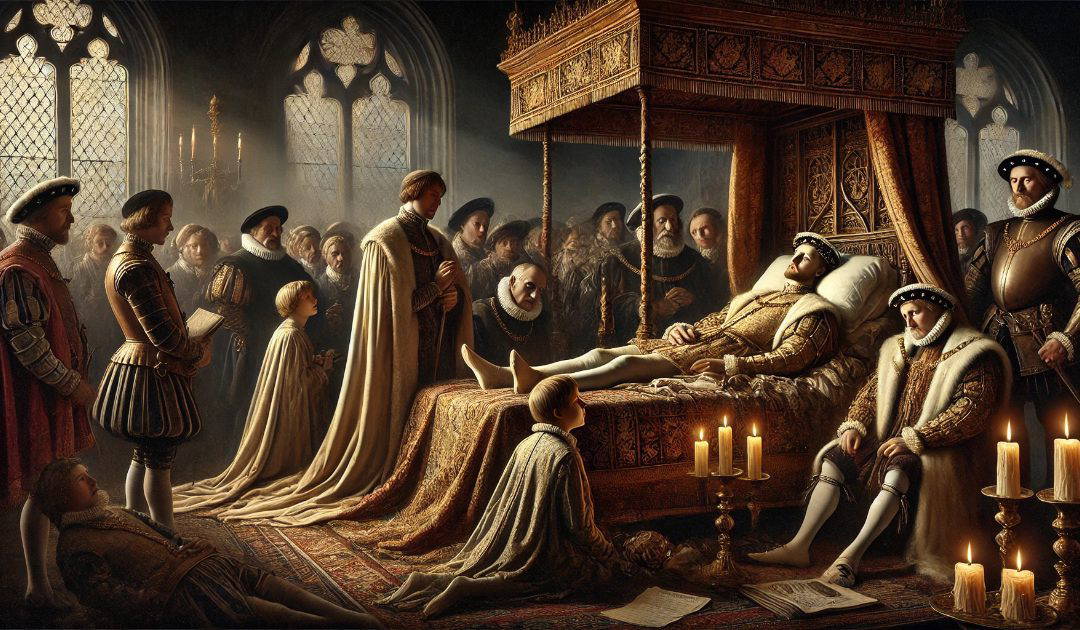On the 28th of January 1547 Edward succeeded his father, Henry VIII, as King Edward VI. It’s another way of saying that Henry VIII died on 28th January 1547.
King Edward VI of England, born on October 12, 1537, was the son of Henry’s third wife Jane Seymour. His reign, which lasted from 1547 to 1553, was marked by significant religious reform and political intrigue, despite Edward’s young age and the challenges posed by his health.
Due to his minority, a regency council was established to govern on his behalf. The council was dominated by Protestant reformers, reflecting the religious changes initiated during Henry’s reign. The Lord Protector, Edward Seymour, Duke of Somerset, played a crucial role in the early years of Edward’s reign, steering the country toward Protestantism.
The period of Edward’s rule is often seen as a time of significant religious transformation in England. The Church of England moved further away from Catholic practices, influenced by the Protestant Reformation sweeping across Europe. Under Edward’s reign, the Book of Common Prayer was introduced in 1549. Compiled by Thomas Cranmer, the Archbishop of Canterbury, this book established a new liturgy for the Church of England, promoting services in English rather than Latin and emphasizing a more personal relationship with God.
Edward’s reign also saw the enactment of the Act of Uniformity in 1549, which mandated the use of the Book of Common Prayer in all churches. This act was a significant step in consolidating Protestant practices and reducing the influence of Catholicism in England. The religious reforms, however, were met with resistance, leading to uprisings, most notably the Prayer Book Rebellion in 1549, which protested against the imposition of the new liturgy.
Despite the religious upheaval, Edward VI’s reign was also characterized by efforts to improve the governance of England. The regency council, particularly under Somerset’s leadership, attempted to address social issues, including the rising inflation and the economic challenges facing the country.
In 1550, Edward Seymour was replaced by John Dudley, Duke of Northumberland, who became the new Lord Protector. Dudley was more politically astute and sought to consolidate power, leading to further religious reforms and the expansion of Protestantism. Under his influence, the Second Book of Common Prayer was introduced in 1552, which further distanced the Church of England from Catholic traditions.
Edward VI’s health was a constant concern throughout his short life. He suffered from various illnesses, and by 1553, it became evident that he was gravely ill. As his condition worsened, the question of succession became paramount. Edward, recognizing the potential for a Catholic restoration under his half-sister Mary, sought to alter the line of succession. He named Lady Jane Grey, a Protestant cousin, as his successor in his will, effectively disinheriting Mary and Elizabeth.
Edward VI died on 6th July 1553 at the age of 15, after a reign of just six years. His death led to a brief and tumultuous period of succession. Lady Jane Grey was proclaimed queen, but her reign lasted only nine days before Mary I, Edward’s half-sister, successfully claimed the throne. Mary’s ascension marked a return to Catholicism and the reversal of many Protestant reforms initiated during Edward’s reign.
Edward VI is often remembered as a symbol of the Protestant Reformation in England, despite his short life and reign. His efforts to establish a Protestant church and his influence on religious practices left a lasting impact on the Church of England. His reign, characterised by political manoeuvering, religious conflict, and the challenges of a young monarch, reflects the complexities of a nation in transition.

